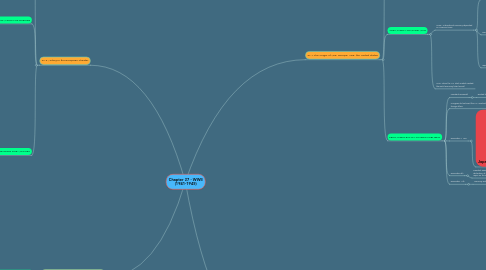
1. 27.3 Victory in the European Theater
1.1. WARTIME DIPLOMACY
1.1.1. Roosevelt's vision
1.1.1.1. wanted the U.S. to succeed Britain as the leader of Western capitalist democracies
1.1.1.1.1. free trade and decolonization rather than the imperial system
1.1.1.2. 1941
1.1.1.2.1. Roosevelt had not yet met with Stalin
1.1.2. The Big 3
1.1.2.1. Roosevelt - Churchill - Stalin
1.1.2.1.1. thrown together due to their common enemies
1.1.3. Wartime Conferences
1.1.3.1. January 1943
1.1.3.1.1. Casablanca, Morocco
1.1.3.2. November 1943
1.1.3.2.1. The Big 3 met in Tehran, Iran
1.2. THE INVASION OF EUROPE
1.2.1. Soviet Union
1.2.1.1. constant struggles with the Germans over Stalingrad and Leningrad
1.2.1.1.1. Stalin urged his allies to invade France
1.2.2. D-Day
1.2.2.1. June 6, 1944
1.2.2.1.1. Allied forces stormed the beaches of northern France - beginning at 6:30 AM
1.2.2.1.2. 24,000 troops
1.2.2.1.3. more then 10,000 wounded or killed
1.2.2.2. August 20, 1944
1.2.2.2.1. Paris was finally liberated
1.2.2.3. the invasion did help relieve some pressure from Stalin's troops
1.2.2.3.1. diverted German forces from the eastern front to the western front
1.2.3. Battle of the Bulge
1.2.3.1. December 16, 1944
1.2.3.1.1. continued until January of 1945
1.2.3.2. Germany was not ready to surrender
1.2.3.3. attempt to divide the Western Allies
1.2.3.4. lost approx. 90,000 Americans (wounded/killed/lost in action)
1.2.3.5. Germans succeeded in hurting the Allies but ultimately it hurt them even more
1.2.3.5.1. resources were exhausted and never regained the same offensive operations
1.3. YALTA AND PREPARING FOR VICTORY
1.3.1. February 1945
1.3.1.1. last time the Big 3 met - Yalta in the Soviet Union
1.3.1.2. Roosevelt was sick
1.3.1.3. Churchill & Roosevelt accepted several compromises that strengthened Stalin's position in eastern Europe
1.3.1.3.1. *allowed the Communist government installed by the Soviet Union in Poland to remain in power
1.3.1.4. Stalin restated his commitment to enter the war against Japan after Germany surrendered
1.3.1.4.1. He also said the Soviet Union would join the United Nations
1.3.1.5. All 3 left with many details unclear
1.3.1.5.1. the plan was to finalize details at the next meeting
1.3.2. April 30, 1945
1.3.2.1. Hitler committed suicide
1.3.3. May 8, 1945
1.3.3.1. Germany surrendered
1.3.4. July 1945
1.3.4.1. Potsdam Summit Conference
1.3.4.1.1. objective: how to rebuild Europe
1.3.4.1.2. Stalin, Truman, Churchill, & Clement Atlee (the incoming British Prime Minister) attended the conference
2. 27.4 The Pacific Theater and the Atomic Bomb
2.1. DROPPING THE ATOMIC BOMB
2.1.1. The Atomic Bomb (Documentary)
3. 27.1 The Origin of War: Europe, Asia, the United States
3.1. ISOLATION
3.1.1. 20s and 30s
3.1.1.1. some Americans support active engagement in European affairs
3.1.1.1.1. others though involvement it would prevent the U.S. from making independent decisions
3.1.2. 1928
3.1.2.1. Kellogg-Briand Pact
3.1.2.1.1. declared war and international crime
3.1.2.1.2. the U.S. & 14 other nations
3.1.2.1.3. the intent was to prevent another world war / more peaceful world
3.1.2.1.4. the agreement was unsuccessful because none of the nations involved committed any of the other nations to take actions in the event of treaty violations
3.2. THE MARCH TOWARD WAR
3.2.1. 1920s - international economy depended on American loans
3.2.1.1. 1919 - Benito Mussolini created the Fasci Italiani di Combattimento (Italian Combat Squadron) based on the economic depression of Italy
3.2.1.1.1. fascism
3.2.1.2. Germany
3.2.1.2.1. economy was also struggling
3.2.1.3. Japan
3.2.1.3.1. militaristic politicians took control in the 30s
3.2.1.3.2. 1936
3.2.2. 1929 - when the U.S. stock market crashed, the world economy failed as well
3.3. FROM NEUTRALITY TO ENGAGEMENT
3.3.1. President Roosevelt
3.3.1.1. wanted to intervene
3.3.1.1.1. aware of the challenges facing the targets of Nazi aggression in Europe and Japanese aggression in Asia
3.3.2. Congress did not want the U.S. involved in foreign affairs
3.3.2.1. Neutrality Acts - second half of the 1930s
3.3.2.1.1. created to ensure that the U.S. did not get drawn into another war
3.3.3. December 7, 1941
3.3.3.1. Japanese attacked Pearl Harbor
3.3.4. December 8th
3.3.4.1. President Roosevelt asked congress for a declaration of war, which it delivered to Japan on the same day
3.3.4.1.1. the U.S. officially enters WWII
3.3.5. December 11th
3.3.5.1. Germany and Italy declared war on the US
3.3.5.1.1. due to their alliance with Japan
4. 27.2 The Home Front
4.1. MOBILIZING A NATION
4.1.1. to win a war you need 3 things:
4.1.1.1. money
4.1.1.1.1. the U.S. economy was getting stronger on account of the New Deal
4.1.1.2. troops
4.1.1.2.1. the draft
4.1.1.3. resources
4.1.1.3.1. Roosevelt's New Deal upset some business owners
4.2. WOMEN IN THE WAR: ROSIE THE RIVETER AND BEYOND
4.2.1. 270 ch 10
